13 Quick Growing Fall Vegetables
This post may contain affiliate links, which means that I may receive a commission if you make a purchase using these links. As an Amazon Associate I earn from qualifying purchases.
Revamp your garden with fast-maturing fall vegetables for a bountiful autumn harvest. Discover 13 cool season crops ready to enjoy in just 60 days!
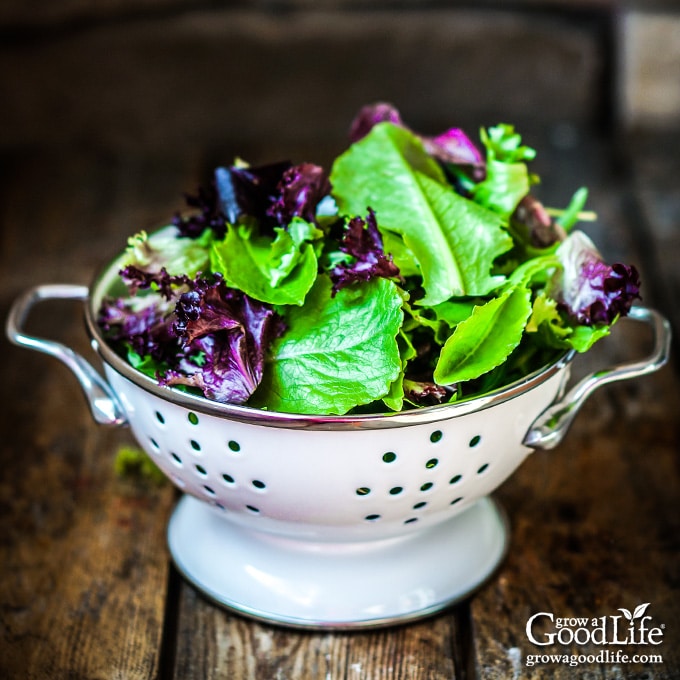
The vegetable garden shines in summer with abundant harvests. As fall approaches, most of the summer crops begin to wind down. Cooler nighttime temperatures and diminishing sunlight take their toll.
The heat-loving plants respond by slowly reducing their growth. They struggle to produce that final fruit or vegetable; they devote all their energy to growing and ripening it. The foliage often shows signs of stress, insect damage, and disease as the plants attempt to give up their final offerings.
Instead of watching your summer crops struggle to ripen the last few fruits, pull them out and plant some of these quick-growing cool-season vegetables for your fall garden.
You can keep the garden producing healthy crops well into fall by replacing your struggling summer plants with fast-maturing vegetables that thrive in the cooler weather and lower autumn daylight hours.
Fall Vegetable Garden Planting Tips
Temperatures can fluctuate wildly in late summer. Days are often hot, but nights can be much cooler. Germinating seeds in hot weather can be difficult. Warm temperatures may prevent seeds from sprouting, and hot weather will quickly dry the soil. As the season cools down, there is also the danger of a dip in nighttime temperatures and an early fall frost.
Below is an overview of some of the challenges of a fall vegetable garden. You can learn more with our in-depth guide: Tips for Growing a Fall Vegetable Garden.
Choosing the Right Crops
When planning your fall vegetable garden, the key to success lies in selecting the right crops that thrive in cooler temperatures and have short days to maturity.
Begin by using your first expected frost date as a guide – you can easily find this information by entering your zip code on PlantMaps.com. With the first frost date in mind, look for cool-season crops that can mature within the remaining days before the frost.
To ensure ample time for a successful fall harvest, check the seed package or catalog for the average days to harvest for each crop. Keep in mind that as the days become shorter in autumn, the growth rate may slow down. Add a week or two to the stated days to maturity to account for the decreased daylight hours. This will give you a more realistic estimate of when you can expect your crops to be ready for harvest.
Many leafy greens, such as lettuce, spinach, and mustard greens, are excellent choices for quick-growing fall vegetables and often mature within 60 days. A clever trick is to harvest these greens at their baby stage, which takes even less time, giving you delicate and delicious salads or homemade soups additions. This way, you can enjoy the fruits of your labor even before they reach full maturity, extending the joy of your fall vegetable garden from planting to plate.
Starting Seeds in Hot Weather
Some vegetable seeds may struggle to sprout during hot weather, leading to germination and seedling establishment challenges. For instance, lettuce and spinach seeds won’t germinate effectively when the soil temperature surpasses 75˚F.
Monitor the soil temperature to ensure optimal conditions for seed germination, which can differ from the air temperature. For accurate readings, consider using a probe-type soil thermometer. The University of California provides a helpful resource listing the optimum soil temperatures at which various vegetable seeds perform best for germination: Soil Temperature Conditions for Vegetable Seed Germination.
If the weather is too hot, consider starting seedlings under lights indoors in late July or early August. Once the weather cools, harden off your seedlings and transplant them into the garden. You can learn more about growing transplants indoors in this article: 10 Steps to Starting Seedlings Indoors.
If your garden experiences partial shade due to nearby trees, consider it an excellent spot for planting fall crops. The shade offers a cool respite during the late summer heat, enabling your plants to establish themselves comfortably. As the leaves fall and more sunlight filters through, your crops will thrive and flourish, taking advantage of the increased light availability.
Providing Proper Moisture
Garden soil dries out much quicker in hot weather, making it difficult to maintain the moisture level that seeds need to germinate and young plants to become established.
Pre-sprouting or soaking seeds beforehand allows the seed to absorb enough moisture to trigger it to sprout. Once the seed germinates, it can be planted directly into the garden. Learn How to Pre-Sprout Seeds.
After planting seeds, water well and keep the soil evenly moist until the seedlings emerge and become established. Once the plants begin to grow, let the soil dry slightly in between watering.
If you are planting fall transplants, water them well in hot weather and provide some shade until the young plants become established, and then water when the soil is dry a few inches below the surface. Add a layer of organic garden mulch to help conserve moisture. As the weather cools, your plants should take off.
How to Deal with Early Frosts
Most cool-season crops can withstand a few light frosts once they are established, but young plants and newly emerged seedlings may be vulnerable.
Watch the weather and be prepared to cover young seedlings if the weather dips to freezing temperatures overnight. With some frost protection during cool nights, most fall crops will continue to grow and produce well into early winter.
13 Cool Season Crops Ready in 60 Days:
When the days start getting shorter, and a chill fills the air, it’s the perfect time to focus on quick-growing fall vegetables. These fast-maturing fall veggies will bring fresh flavors to your table in no time.
Even if your growing season is short, you can still enjoy plenty of harvests from your fall garden if you plant the right varieties. With proper planning and the right selection of crops, you can enjoy a bountiful harvest even as the temperatures drop.
So pull out the summer plants, such as tomatoes, cucumbers, bush beans, and zucchini, that are no longer producing, clear out any weeds, work in some compost into the soil, and sow some of these quick growing fall crops:
Arugula
Arugula, also known as Rocket, is a peppery and nutrient-packed green that thrives in cool temperatures. It can be ready for harvest in as little as 40 to 50 days, making it an ideal choice for quick fall planting.
- Sow and Grow: Sow arugula seeds directly in the garden or start seeds indoors. Keep the soil consistently moist for successful germination and growth. Thin the seedlings to maintain 6 to 8 inches spacing for better development.
- Harvest: Begin cutting outer leaves once they are at least 2 inches long. Allow the plant to continue to produce harvests.
- Varieties to Consider: Astro Arugula, Esmee Arugula, Wild Rocket, and Uber Arugula.
Baby Carrots
Select early maturing varieties and harvest around 60 days at baby stage for a delicate, sweet flavor. Carrots can withstand some light frosts but harvest before the ground freezes to prevent the tender, young roots from rotting.
- Sow and Grow: For detailed instructions on how to grow carrots successfully in your fall garden, check out our growing guide: How to Grow Carrots.
- Harvest: Carrots are ready to harvest when their shoulders are 1/2 to 3/4 inches in diameter. Enjoy their sweet and delicate flavor in salads, stews, or as a crunchy snack.
- Varieties to Consider: Little Finger, Red Cored Chantenay, Tonda di Parigi, and Thumbelina.
Beets
Beets are a versatile and colorful addition to your fall garden, offering both delicious greens and flavorful roots. Harvest the fresh beet greens in approximately 30 days and the tender beetroot in around 60 days.
- Sow and Grow: For tips on growing beets successfully from seed to harvest, don’t miss our guide on How to Grow Beets.
- Harvest: Harvest beet greens when they reach about 5 inches tall. For the tender and sweet beetroots, harvest when they are around 2 to 3 inches in diameter. The greens are delicious sautéed with garlic and olive oil. Enjoy eating your homegrown beets roasted, pickled, or used in salads and soups.
- Varieties to Consider: Detroit Dark Red, Chioggia, and Touchstone Gold.
Bok Choy
Bok Choi, also known as Pac Choi, is a rapid-growing vegetable that adds a delightful crunch and mild flavor to your fall garden. Enjoy tender baby Bok Choy in as little as 30 days. Perfect for stir-fries, soups, or fresh salads.
- Sow and Grow: To sow seeds, prepare a well-draining soil bed in your garden or sow indoors. Sow the seeds about 1/4 inch deep, spacing them approximately 4 to 6 inches apart. Keep the soil consistently moist during germination and early growth.
- Harvest: As your bok choy plants grow, snip the outer leaves once they are of a desirable size (baby stage). Harvesting the outer leaves allows the inner leaves to continue developing, ensuring a continuous harvest throughout the fall season.
- Varieties to Consider: Baby Choi, White Stem Bok Choy, and Toy Choy.
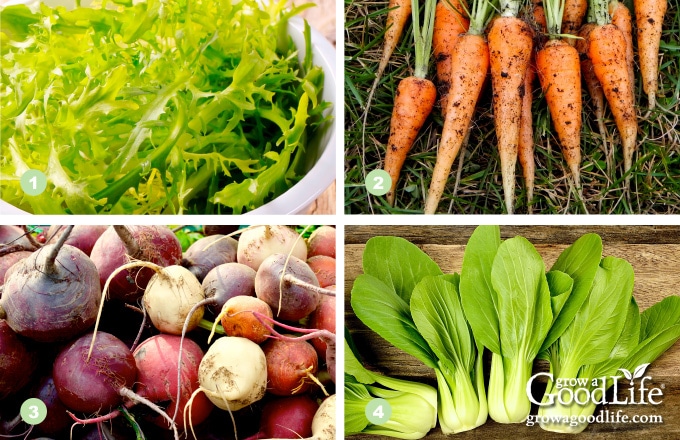
Kale
Kale, a nutrient-rich and versatile leafy green is a star performer in the fall garden. Enjoy the small, tender leaves in as little as 30 days, making a delightful addition to fall salads. For fully mature leaves, allow kale to grow for about 60 days.
- Sow and Grow: For details on growing kale, check out our guide on How to Grow Kale.
- Harvest: To harvest kale, snip the outer leaves as they reach a desirable size, allowing the plant to continue producing more leaves. This harvesting method ensures a continuous supply of fresh kale throughout the fall season.
- Varieties to Consider: Dwarf Blue Curled, Lacinato Dinosaur, Redbor, and Red Russian.
Lettuce
Leaf lettuce is a quick-growing and versatile green that adds a burst of color and flavor to your fall garden. Enjoy the satisfaction of harvesting fresh lettuce leaves in as little as 30 days. Cooler weather intensifies the color of red leaf varieties, making them even more visually appealing.
- Sow and Grow: To learn how to grow lettuce successfully from seeds to harvest, refer to our guide: How to Grow Lettuce.
- Harvest: Harvest lettuce by snipping the outer leaves when they reach a suitable size, allowing the plant to continue growing and producing more foliage.
- Varieties to Consider: Black Seeded Simpson, Mesclun Baby Greens Mix, and Red Oak Leaf.
Mustard Greens
Mustard greens bring a peppery and tangy flavor to your fall garden, making them a delightful addition to salads and other dishes. One popular variety, Japanese mustard, Mizuna, boasts slightly bitter, mustard-flavored lobed leaves that blend perfectly with salad greens and are crisp enough to hold up well in steaming and stir-frying.
- Sow and Grow: To grow mustard greens, sow the seeds directly in well-prepared garden soil or containers. Ensure the soil remains consistently moist during germination and early growth. Mustard greens prefer full sun but can tolerate some shade, especially in warmer regions. Keep in mind that they tend to bolt in hot weather, so fall planting ensures the best results. Thin the seedlings to maintain adequate spacing for better leaf development.
- Harvest: Harvest mustard greens when the baby leaves are about 30 days old, while mature leaves are ready for harvest in approximately 60 days. The flavor intensifies as the plant matures. To harvest, cut the outer leaves once they reach at least 3 inches long. Doing so allows the plant to continue growing and producing more foliage.
- Varieties to Consider: Mizuna Mustard, Florida Broadleaf, Red Carpet, and Red Giant Mustard.
Radishes
Radishes are a delightful addition to your fall garden, offering a burst of peppery flavor that complements soups, salads, and various dishes. Enjoy the satisfaction of harvesting radishes in as little as 20 days, making them one of the fastest-growing vegetables.
- Sow and Grow: This guide provides step-by-step instructions for sowing radish seeds, caring for the plants, and ensuring a bountiful harvest of these zesty root vegetables: How to Grow Radishes.
- Harvest: Radishes are ready for harvest when they reach around 1 inch in diameter, typically after 30 days of growth. The greens of radishes are edible too, and can be used in salads or cooked dishes, reducing waste and increasing the versatility of this vegetable.
- Varieties to Consider: Cherry Belle, French Breakfast, and Watermelon Mantanghong.
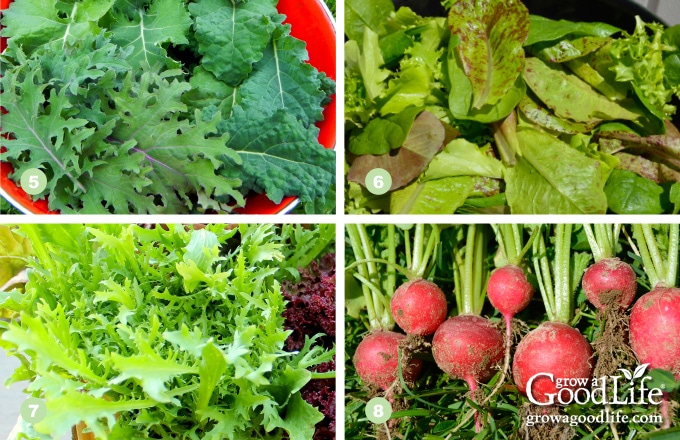
Scallions or Green Onions
Scallions, also known as green onions, are a versatile addition to your fall garden, providing a mild onion flavor that complements salads, cooked recipes, and stir-fries. Enjoy the satisfaction of harvesting scallions at pencil size within just 30 days.
- Sow and Grow: For tips on how to grow green onions successfully, refer to our detailed guide: How to Grow Green Onions.
- Harvest: Scallions are ready for harvest when they reach pencil size, typically around 30 days after sowing. You can pull 6-inch tall scallions at any stage, allowing others to continue developing. The onion flavor intensifies as scallions mature, making them a versatile ingredient in various dishes. Hearty varieties of scallions can overwinter and will begin growing again in the following spring.
- Varieties to Consider: Evergreen Bunching Onions, Parade Bunching Onions, and Tokyo Long White Scallions.
Spinach
With its vitamin-rich and flavorful dark-green leaves, spinach is a true gem in your fall vegetable garden. Enjoy the goodness of fresh spinach in as little as 30 days, making it perfect for salads and winter soups.
- Sow and Grow: Check out our full growing guide for step-by-step instructions for sowing spinach seeds, caring for the plants, and ensuring a continuous harvest of these nutritious greens: How to Grow Spinach.
- Harvest: Harvest spinach when the baby leaves are ready, typically around 30 days after sowing. For mature leaves, wait for about 45 days before harvesting. To preserve the plant’s productivity, snip the outer leaves as they reach a suitable size, allowing it to continue producing more foliage.
- Varieties to Consider: Bloomsdale, Space, and Tyee.
Swiss Chard
With its tender and vibrant leaves, Swiss chard adds a splash of color and nutrition to your fall garden. Enjoy the delight of harvesting young leaves in just 45 days, making them an excellent choice for fresh salads and culinary creations.
- Sow and Grow: For tips for growing Swiss chard, refer to our detailed guide: How to Grow Swiss Chard.
- Harvest: Harvest Swiss chard by snipping the tender, young leaves when they reach about 3 inches in size, ideal for fresh salads. To maintain a continuous harvest, pick the outer leaves as needed, allowing more leaves to grow from the center of the plant. This harvesting method ensures a steady supply of vibrant and delicious Swiss chard leaves throughout the fall season.
- Varieties to Consider: Celebration, Fordhook Giant, and Ruby Red.
Tatsoi
With its mild mustard flavor, tatsoi mixes well in salads, stir-fries, and soups. Enjoy the tender and baby leaves, which are ready for harvesting in just 25 days, boasting a taste reminiscent of spinach. The full-sized plant can be harvested within 50 days, providing an abundance of versatile greens.
- Sow and Grow: Sow the seeds directly in well-prepared garden soil or containers. Ensure the soil remains consistently moist during germination and early growth. Tatsoi thrives best in cooler temperatures, making it a great addition to your fall garden. Thin the seedlings to provide adequate spacing for the plants to develop fully.
- Harvest: For baby leaves, cut the outer leaves once they reach about 4 inches in length, allowing the plant to continue producing more tender foliage. When harvesting the full-sized plant, cut Tatsoi at the stem, ensuring a continuous supply of these flavorful greens.
- Variety to Consider: Tatsoi Rosette features compact rosettes of tender leaves, making it a perfect choice for salads and stir-fries, providing a delightful twist to your culinary creations.
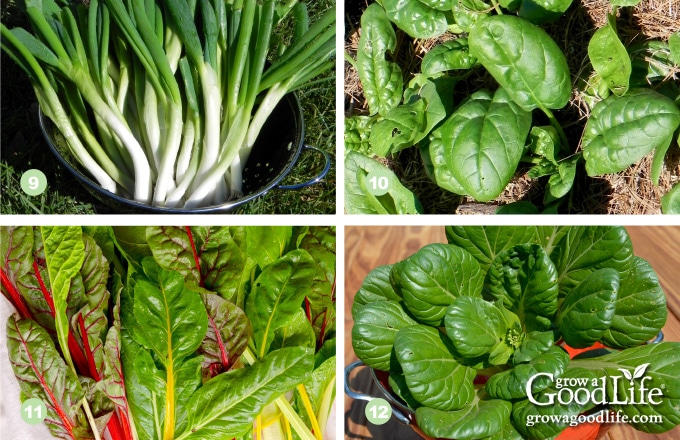
Turnips
Turnips are a versatile and rewarding addition to your fall garden, offering both delicious greens and flavorful roots. Enjoy the tender and nutrient-rich greens ready for harvesting in just 30 days. The roots can be harvested within 60 days, and cool fall temperatures further sweeten their flavor.
- Sow and Grow: Sow the seeds directly in well-prepared garden soil, thin as needed, so they are spaced adequately to allow for proper root development. Keep the soil moist during germination and growth to ensure healthy plant development.
- Harvest: For the greens, cut a few leaves from the tops of each plant, leaving some foliage for the plant to maintain its photosynthesis process and support root growth. You can enjoy the greens in salads or cooked dishes. For the roots, harvest them at the baby stage for tender, young turnips, or allow them to size up to 2 to 3 inches in diameter for a more mature harvest. They are delicious roasted. Try this Roasted Root Medley recipe.
- Varieties to Consider: Purple Top White Globe, Tokyo, and White Egg.
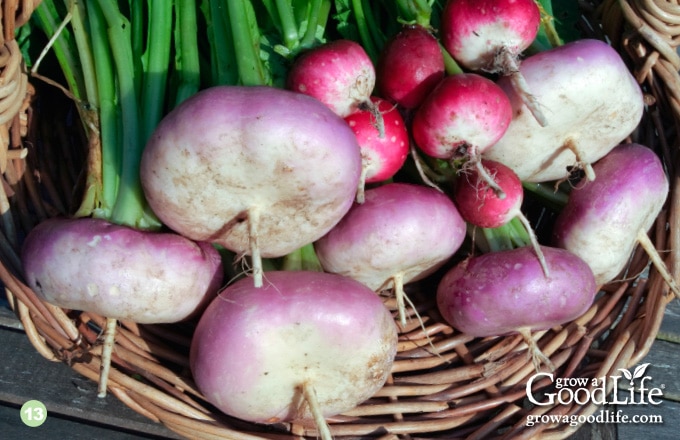
Even in my own zone 5 garden with a shorter growing season, I’ve unlocked the secret to boosting yields by focusing on the rapid-growing fall vegetables mentioned in this article. These hardy plants thrive in cooler temperatures, allowing me to extend the pleasure of homegrown produce well into the fall.
In regions where frost holds off until November or December, gardeners have the luxury of choosing from a diverse array of cool-season vegetables that mature before the ground freezes. If you’re eager to diversify your fall garden with more cool-season crops, I invite you to explore our list of fall vegetables in the article: Tips for Growing a Fall Vegetable Garden.
Although growing fall vegetables in colder climates may present challenges, don’t hesitate to experiment with various techniques and strategies to maximize your yield.
By extending your growing season into fall, you’ll relish the rewards of a bountiful harvest for a little longer. So, take the leap and embark on a fulfilling journey of fall vegetable gardening – you’ll be pleasantly surprised by the delicious rewards that await you!
Good planning is key to a successful vegetable garden
Whether you are new to growing your own food or have been growing a vegetable garden for years, you will benefit from some planning each year. You will find everything you need to organize and plan your vegetable garden in my PDF eBook, Grow a Good Life Guide to Planning Your Vegetable Garden.


I live in American Samoa, where the weather is either hot and sunny or cool and rainy. I want to start a vegetable garden but am not sure what would be good for our weather. I want cucumbers, tomatoes, bok choi, green onions etc…what would you recommend.
Hi Crystal, I don’t know how to garden in such a tropical climate. The only thing I could suggest is trying a few things at a time and take notes.
Crystal,
Understand where you live.
Firstly, it is an isolated island. Out of fear of (potentially) invasive species and the ecological havoc/extinctions they cause, many plants that are not already on the island will likely be illegal to import. Try to get a copy of the regulations, so you know what is legal. I don’t live there and can’t help much.
Secondly, you don’t even have a cool season as the author(s) of this article understand one. Learn to eat what grows in your climate, not cool season crops from northern Eurasia which are almost guaranteed to die. I will attempt to suggest some substitute crops, but remember to check their legal status:
For tomatoes, you might succeed with the Everglades Landrace (a feral cherry/currant tomato), but also consider tamarillos (Cyphomandra betacea, aka “tree tomatoes”). Instead of cucumbers, try Coccinia grandis, chayote, or even okra. Instead of green onions, try society garlic (Tulbaghia violacea), though southern strains of garlic chives and wild onions native to South Texas have a fighting chance of success. Be aware that onion seed loses viability quickly. The young foliage of Toona sinensis (fragrant spring tree, Chinese mahogany) is supposed to be garlicky when stir fried. I don’t know if the related, but more tropical “Spanish” (actually Cuban) cedar (Cedrela odorata I think) is edible or not. There are of course many tropical spices to perk up foods, just not often oniony. Personally I would abandon the whole cabbage clan, though Ethiopian kale and some mustard greens succeed in hot places. Moringa trees (coppice them to keep them in harvestable reach and because these things grow very fast and have quite week, brittle wood) are a better choice. The raw leaves taste like arugula, but become very neutral and palatable cooked. Cat’s whiskers or African cabbage (Cleome gynandra) should also work–cook it like mustard greens.
Other vegetables: Malabar spinach (Basella alba / rubra–watch for invasiveness), Sissoo or Brazilian Spinach (a *sterile* form of Alternathera), Lagos spinach (a type of Celosia; boil with a change of water as it has lots of tannin), Tahitian spinach (Abelmoschus manihot), Chaya / Mayan tree spinach (Cnidoscolus chayamansa)–must be thoroughly cooked because it is related to cassava and is cyanogenic (don’t use aluminum or cast iron pots either), roselle (Hibiscus sabhariffa) and false roselle (Hibiscus acetosella)–these two are sorrel substitutes, water lotus (Nelumbo nucifera) and water spinach / kampong (Ipomoea aquatica) if they are legal (non native aquatics can spread real fast), and of course the Polynesian staple: taro. Yes, taro corms are the starch/calorie staple, but the leaves are also edible IF thoroughly cooked.
Talk to your neighbors! What do they grow?
That was INCREDIBLY informative and well-thought out. I live in Michigan and still found it fascinating. Thank you!
Thanks for the tups.
nice side about gardening point of view.
pleas advise my egg plant flower not stay after rising ,they all fall down not come in to vegetable.
Saba, Blossom drop on eggplants are usually due to stress. Are your plants healthy and getting enough water, nutrients, and sunshine?
I live in So. CAlif., zone 10. WHen can I throw in seeds of parsley ? ….thanks…..Mira
Mira, Parsley is a cool season crop. Ideal times to sow seeds in Southern California would be in October, November or December.
I absolutely love swiss chard and arugula. I’ll have to try growing them. Thanks for the inspiration.
i planted 1 small swiss chard plant and it grew like crazy and multiplied. I have 3 now. when ever I harvest a batch they grow back right away. I mixed it with cabbage and it is delisous
Jazzy, Swiss chard is one of my favorites too! I love that it continues to grow all season long.
You answered my questions on fall gardening in north Florida!
I am so glad. I hope you will experiment and see what will grow for you. 🙂
Will, I’ve been weighing and keeping track of the tomatoes as I process them. But I haven’t added it up yet.